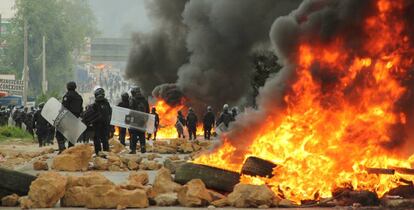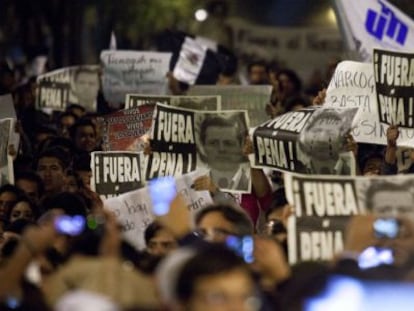Violent clashes break out between teachers and police in Oaxaca
Six reported dead and dozens injured in southern Mexican state during protests over education reform

On Sunday, the Mexican state of Oaxaca experienced a re-run of the nightmare it went through for half a year in 2006: armed clashes between rebel teachers and government security forces.
Six people are reported dead, 55 police officers injured and an undetermined number of protesters wounded by firearms after the police broke up a week-long protest in Nochixtlan. Twenty-one people have been arrested.
In images reminiscent of the conflict that gripped the southern region a decade ago, hundreds of federal police officers confronted protesters with tear gas and firearms, while teachers set fire to cars to use them as barricades, and hurled projectiles at the police. The clashes lasted several hours and several local residents were caught in the crossfire.
There was another violent confrontation in Salina Cruz, in the region of Tehuantepec Isthmus, the site of a Pemex oil refinery
Government and police officials said there was a journalist and two educators among the dead. Meanwhile, the powerful teachers union, the National Coordinating Committee of Education Workers (CNTE), said that five of the victims worked in education, and mentioned them by name: Andrés Aguilar, 29; Yalid Jiménez, 22; Óscar Santiago, 22; Jesús Cadena, 19; and Anselmo Cruz (no age provided).
It later emerged that local reporter Elpidio Ramos, who was covering the clashes, was shot to death by looters inside a store in the municipality of Juchitán.
The protesters have ties to the CNTE, a powerful union with more than 100,000 members nationwide that is particularly strong in the southern states. This union opposes mandatory assessments for teachers introduced into the 2013 federal education reform sponsored by President Enrique Peña Nieto.
A de facto power
The CNTE, which is considered a de facto power in Mexico’s southern states, has a long tradition of organizing boycotts and violent attacks.
Just before the June 7, 2015 midterm elections, radical groups blocked highways, took over airports, and set fire to local election headquarters.
The Peña Nieto government was forced to suspend the reform one week before the race to avoid more violence, but then restarted the process soon after.
Oaxaca has a long tradition of producing schoolteachers. But their precarious conditions have created social movements at the origin of numerous conflicts in the area. The best-known one, which dates back to 2006, resulted in dozens of deaths and arrests, and a protest in the capital that affected the regional economy. The regular school year at the primary level was also disrupted.
The conflict flared up again three years ago with the Peña administration’s education reform, which the CNTE opposes.
Local residents complained on social media that police officers were firing live ammunition at the protesters. The Oaxaca police department said that its officers “were wounded by firearms” and the National Security Commission (CNS) stated in a release that federal police were unarmed.
“We are aware that the gunshots originated from individuals not connected to the roadblocks, who began shooting at the population and the federal police in order to create a confrontation,” said the government.
Photographs of the event published by international agencies show several federal police officers holding weapons and pointing rifles from a trench. In a second release, the CNS said that those photographs are “phony.”
Sign up for our newsletter
EL PAÍS English Edition has launched a weekly newsletter. Sign up today to receive a selection of our best stories in your inbox every Saturday morning. For full details about how to subscribe, click here.
But later, at an evening press conference with Governor Gabino Cué Monteagudo, Federal Police Chief Enrique Galindo admitted that a group of officers did use weapons.
On Saturday, federal judges issued a prison warrant against two leading members of CNTE’s Section 22, on corruption charges. Section secretary general Rubén Núñez is accused of operating with illegally gained funds, and organization secretary Francisco Villalobos is charged with stealing.
There was another violent confrontation in Salina Cruz, in the region of Tehuantepec Isthmus, the site of a Pemex oil refinery.
Close to midnight, the National Human Rights Commission (CNDH) issued a release with guidelines for medical attention for the injured, and a reminder that any action by the authorities must respect “international protocols and standards, with a priority on dialogue at all times.”
This agency said it has sent out a “significant” number of observers and support personnel to Oaxaca to help ensure that all government action remains within the bounds of the law.
English version by Susana Urra.
Tu suscripción se está usando en otro dispositivo
¿Quieres añadir otro usuario a tu suscripción?
Si continúas leyendo en este dispositivo, no se podrá leer en el otro.
FlechaTu suscripción se está usando en otro dispositivo y solo puedes acceder a EL PAÍS desde un dispositivo a la vez.
Si quieres compartir tu cuenta, cambia tu suscripción a la modalidad Premium, así podrás añadir otro usuario. Cada uno accederá con su propia cuenta de email, lo que os permitirá personalizar vuestra experiencia en EL PAÍS.
¿Tienes una suscripción de empresa? Accede aquí para contratar más cuentas.
En el caso de no saber quién está usando tu cuenta, te recomendamos cambiar tu contraseña aquí.
Si decides continuar compartiendo tu cuenta, este mensaje se mostrará en tu dispositivo y en el de la otra persona que está usando tu cuenta de forma indefinida, afectando a tu experiencia de lectura. Puedes consultar aquí los términos y condiciones de la suscripción digital.
More information
Archived In
Últimas noticias
The complicated life of Francesca Albanese: A rising figure in Italy but barred from every bank by Trump’s sanctions
Half of Scotland is in the hands of 420 property owners
How Japan is trying to avert ‘digital defeat’
From digital curfews to blocking apps: How technology experts protect their children online
Most viewed
- Why we lost the habit of sleeping in two segments and how that changed our sense of time
- Trump’s obsession with putting his name on everything is unprecedented in the United States
- Pablo Escobar’s hippos: A serious environmental problem, 40 years on
- The Florida Keys tourist paradise is besieged by immigration agents: ‘We’ve never seen anything like this’
- Charles Dubouloz, mountaineering star, retires at 36 with a farewell tour inspired by Walter Bonatti










































